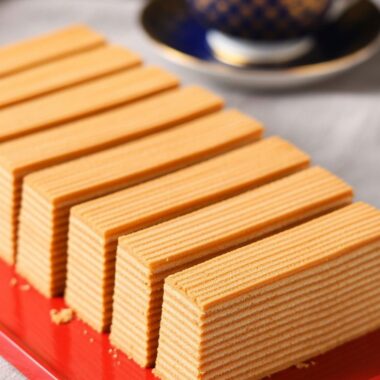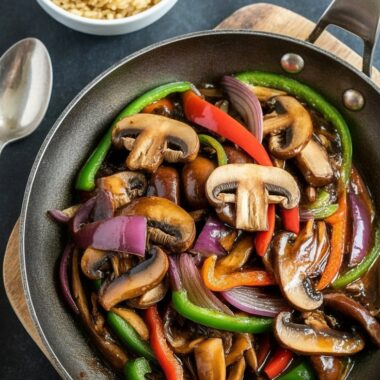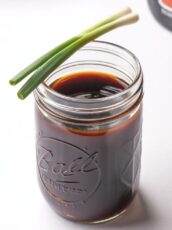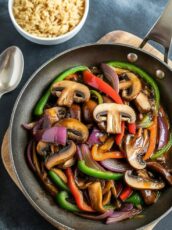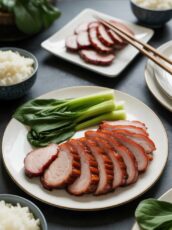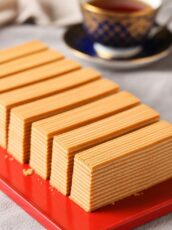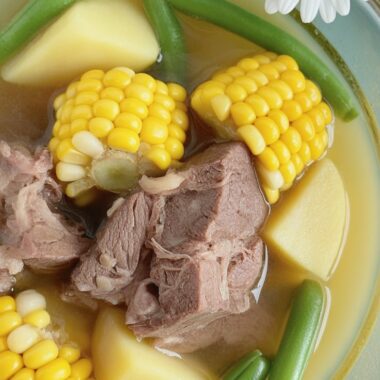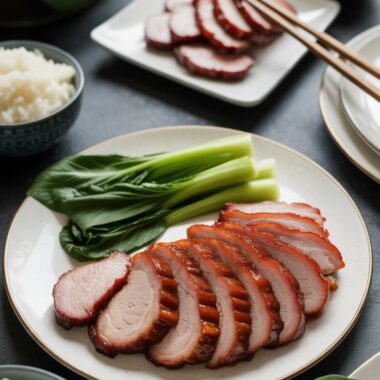If there’s one dish that makes me think of lazy Sunday afternoons at home, it’s char siu pork. That deep caramelized glaze, the balance of sweet and savory, and the way it perfumes the whole kitchen while roasting — it always takes me back to the first time I tried making it for a family gathering. Everyone hovered around the oven, waiting for me to slice into that shiny, mahogany pork.
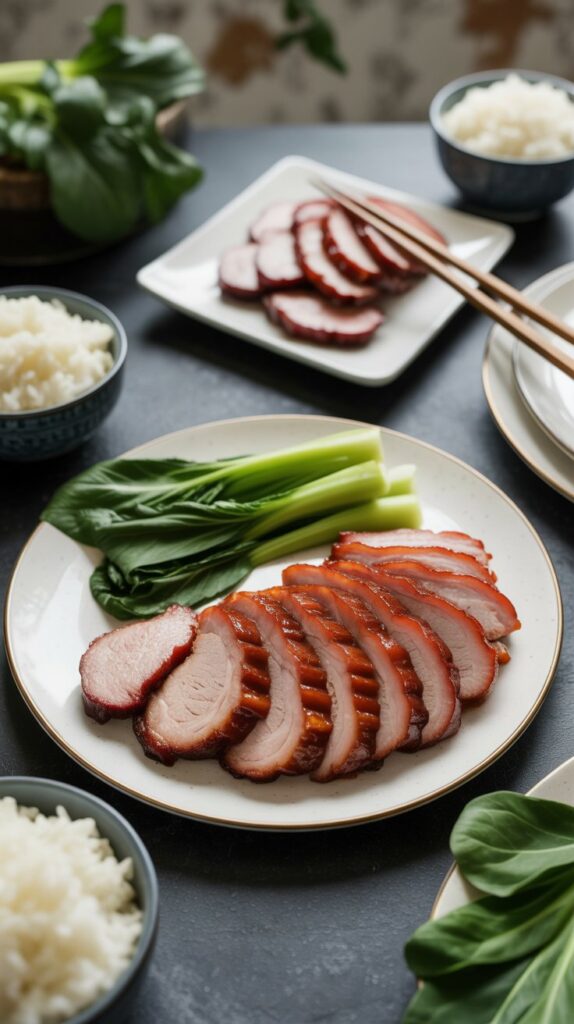
This recipe gives you the same bold flavor you’d find at a Cantonese BBQ shop, but you can easily make it in your own oven without special equipment or artificial coloring.
What Exactly Is Char Siu?
Char siu (literally “fork roasted”) comes from the traditional way of cooking the pork — long strips roasted over a fire, often suspended on large forks. These days, most of us don’t have an open pit in the backyard, so roasting in the oven is the practical way.
Whenever I make char siu, I think of my trips to Hong Kong where entire shop windows glistened with rows of shiny BBQ pork. The smell alone could make you skip whatever you planned for dinner and walk in. That’s the flavor I always try to bring back home.
Ingredients That Make Char Siu Special
The secret to char siu is the marinade. You’ll see a lot of shortcuts online, but I always go for the fermented red bean curd. It gives both the deep color and a funky, savory note you just can’t fake. It’s maroon thanks to red yeast rice, so you don’t need any red food coloring.
Here’s what I typically use:
- Fermented red bean curd & sauce – brings color and a salty, umami base.
- Honey or maltose – maltose gives the best glossy finish, but honey works too. I usually warm maltose a bit so it mixes smoothly.
- Dark soy sauce & molasses – for depth and that almost smoky sweetness.
- Garlic powder & five-spice powder – the spice mix that makes char siu taste unmistakably Cantonese.
- Sugar & salt – to balance everything.
One tip: reserve half the marinade before you soak the pork. That way, you’ll have a clean batch ready to turn into your basting glaze.
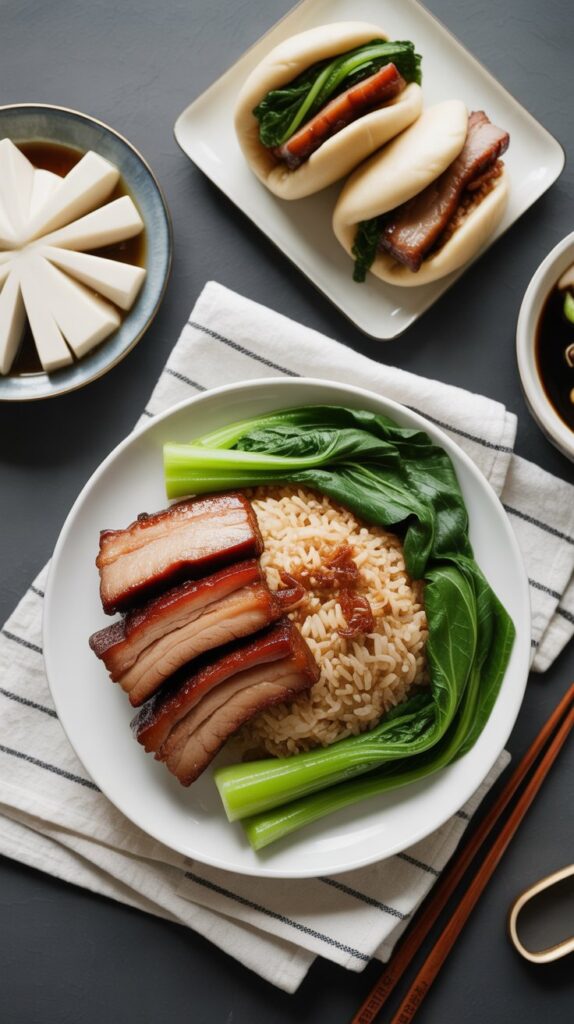
Best Cuts of Pork for Char Siu
I’ve tested this recipe with a few cuts, and here’s what I’ve learned:
- Pork shoulder/butt: My go-to cut. It’s forgiving, juicy, and has the right balance of fat and lean meat. Perfect if you’re worried about overcooking.
- Pork belly: Pure indulgence. Super fatty, melt-in-your-mouth pieces. I love using belly when I’m planning to tuck the meat into bao buns.
- Pork tenderloin: Leaner, but still tender if you marinate well. This is great if you prefer less fat on your plate.
If you’re making this for guests, I like to do a mix — a shoulder for balance and a belly piece for that wow factor.
How I Make Char Siu Pork at Home
Here’s my process step by step:
- Marinate overnight – I always prick the pork with a fork before marinating so the sauce seeps in. Then I let it sit in the fridge at least 8 hours. Overnight is best.
- Room temperature before roasting – Don’t skip this. About 30 minutes on the counter helps the meat cook evenly.
- Set up the roasting pan – I place a rack over a tray with a little water at the bottom. This keeps the pork moist and prevents burnt drippings.
- Baste often – I roast at 375°F for 40–50 minutes, turning and brushing with the glaze every 15 minutes.
- Rest before slicing – Just 10 minutes on the cutting board lets the juices settle, and I give it one last brush of glaze before slicing.
When the pork comes out, the smell is almost impossible to resist. More than once, I’ve had my family picking at the edges before I could even plate it.

Serving Ideas
My favorite way to serve char siu is the simplest: with steamed white rice and stir-fried gai lan (Chinese broccoli). The bitterness of the greens balances the sweet glaze so well.
Other great ideas:
- Tuck slices into char siu bao (steamed buns).
- Chop it into fried rice for a quick weeknight meal.
- Add to noodle soup bowls for extra flavor.
- In a pinch, I’ve even used leftovers in sandwiches with a bit of cucumber and mayo.
Make-Ahead & Storage Tips
Char siu actually tastes better the next day because the flavors deepen. I often make extra, slice it, and drizzle with leftover glaze before storing in an airtight container. It keeps well in the fridge for about 5 days.
For reheating, I prefer the microwave for speed, but if I’m serving guests, I’ll warm the slices in a covered pan with a splash of water — it keeps the pork juicy.
Freezing works too: slice, sauce, and freeze in small batches. That way, you can pull out just what you need for a quick dinner.
Vietnamese/Chinese Barbecue Pork
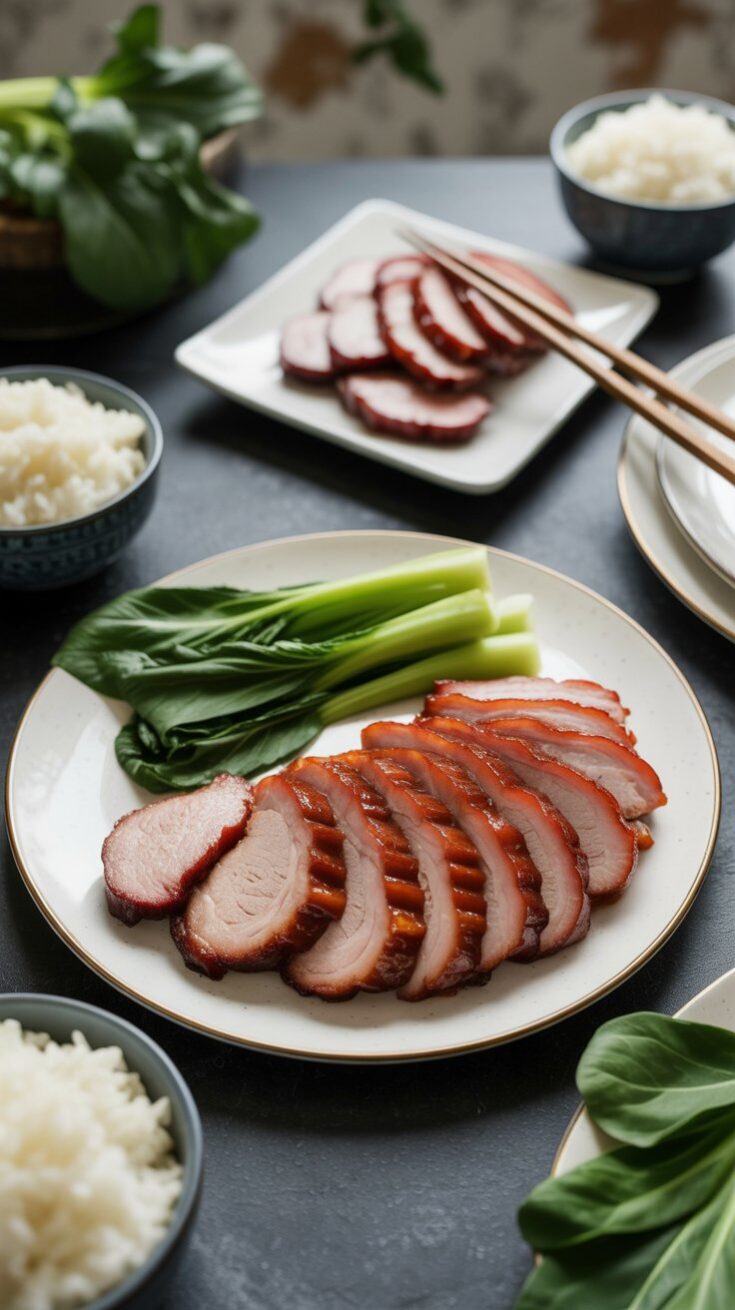
This classic Cantonese dish transforms pork shoulder into juicy, flavorful strips coated in a glossy, caramelized glaze. The savory-sweet marinade, enriched with fermented red bean curd, honey, and five-spice, infuses the meat overnight for maximum flavor. Perfect alongside steamed rice, tucked into bao buns, or sliced over noodles.
Ingredients
For the Marinade
- 680 g (1½ lb) pork shoulder or pork butt
- 50 g (4 tbsp) white sugar
- 56 g (4 tbsp) fermented red bean curd sauce
- 20 g (2 pieces) fermented red bean curd
- 81 g (4 tbsp) honey
- 32 g (2 tbsp) dark soy sauce
- 45 g (2 tbsp) molasses
- 10 g (1 tbsp) kosher salt (Diamond Crystal brand)
- 12 g (3½ tsp) garlic powder
- 1.5 g (¾ tsp) Chinese five-spice powder
For the Basting Sauce
- 67.5 g (3 tbsp) maltose
- 14 g (1 tbsp) boiling water
- Reserved marinade from above
Instructions
- Prepare the pork: Slice the pork shoulder into two long strips.
- Make the marinade: In a small bowl, whisk together sugar, fermented bean curd sauce, bean curd pieces, honey, soy sauce, molasses, salt, garlic powder, and five-spice. Whisk until the bean curd dissolves. Reserve half of this marinade in a separate container for later basting.
- Marinate: Coat the pork strips thoroughly in the remaining marinade. Place in a container with a lid and refrigerate for at least 8 hours, turning halfway through so the meat marinates evenly.
- Bring to room temperature: Remove pork from the fridge 30 minutes before cooking.
- Preheat and prepare basting sauce: Heat oven to 375°F (190°C). Warm the maltose slightly in the microwave until softened, then stir it with boiling water. Mix this into the reserved marinade to make the basting sauce.
- Roast the pork: Arrange the pork on a rack set over a baking sheet. Pour about 1 inch of water into the sheet pan to keep the meat moist. Bake for 20 minutes, flip, and baste generously. Bake for another 15 minutes, flip again, and baste.
- Caramelize: Increase oven temperature to 425°F (220°C) and roast for about 5 minutes, until edges are dark and glossy. The internal temperature should reach at least 145°F (63°C).
- Rest and serve: Transfer the pork to a cutting board, baste once more, and let rest 5 minutes before slicing. Serve hot with rice, bao, or noodles.
Nutrition Information:
Yield: 6 Serving Size: 1Amount Per Serving: Calories: 489Total Fat: 23gSaturated Fat: 4gTrans Fat: 0gUnsaturated Fat: 17gCholesterol: 13mgSodium: 10617mgCarbohydrates: 52gFiber: 1gSugar: 39gProtein: 24g
Asianplated.com, occasionally offers nutritional information for recipes contained on this site. This information is provided as a courtesy and is an estimate only. This information comes from online calculators. Although allchickenrecipes.com attempts to provide accurate nutritional information, these figures are only estimates.
Common Questions I Get
Can I grill char siu instead of roasting?
Yes, and it adds a smoky flavor. Just watch the heat because the sugar in the glaze burns quickly.
Do I need maltose, or is honey fine?
Honey works, but maltose gives you that classic glossy look you see in restaurants. I keep a jar just for this recipe.
Why is my char siu not red like the restaurants?
If you skip food coloring, it won’t be bright red, but the flavor is what counts. Fermented red bean curd gives a natural, deep shade that looks beautiful.
Try other Vietnamese recipes:

